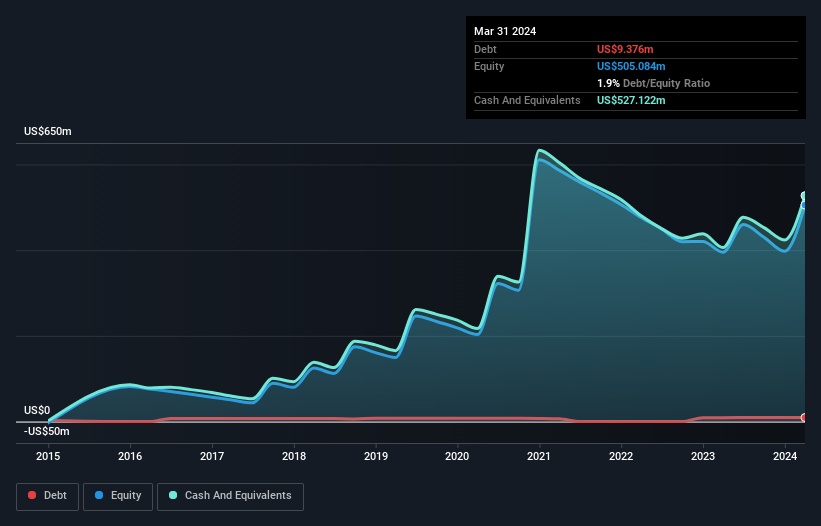
Warren Buffett famously said, 'Volatility is far from synonymous with risk.' It's only natural to consider a company's balance sheet when you examine how risky it is, since debt is often involved when a business collapses. We note that Kura Oncology, Inc. (NASDAQ:KURA) does have debt on its balance sheet. But the more important question is: how much risk is that debt creating?
Why Does Debt Bring Risk?
Debt assists a business until the business has trouble paying it off, either with new capital or with free cash flow. Part and parcel of capitalism is the process of 'creative destruction' where failed businesses are mercilessly liquidated by their bankers. However, a more frequent (but still costly) occurrence is where a company must issue shares at bargain-basement prices, permanently diluting shareholders, just to shore up its balance sheet. Of course, plenty of companies use debt to fund growth, without any negative consequences. The first thing to do when considering how much debt a business uses is to look at its cash and debt together.
Check out our latest analysis for Kura Oncology
What Is Kura Oncology's Debt?
The chart below, which you can click on for greater detail, shows that Kura Oncology had US$9.38m in debt in March 2024; about the same as the year before. However, it does have US$527.1m in cash offsetting this, leading to net cash of US$517.7m.

How Healthy Is Kura Oncology's Balance Sheet?
Zooming in on the latest balance sheet data, we can see that Kura Oncology had liabilities of US$32.3m due within 12 months and liabilities of US$16.6m due beyond that. On the other hand, it had cash of US$527.1m and US$4.30m worth of receivables due within a year. So it can boast US$482.6m more liquid assets than total liabilities.
This surplus liquidity suggests that Kura Oncology's balance sheet could take a hit just as well as Homer Simpson's head can take a punch. With this in mind one could posit that its balance sheet means the company is able to handle some adversity. Succinctly put, Kura Oncology boasts net cash, so it's fair to say it does not have a heavy debt load! There's no doubt that we learn most about debt from the balance sheet. But ultimately the future profitability of the business will decide if Kura Oncology can strengthen its balance sheet over time. So if you're focused on the future you can check out this free report showing analyst profit forecasts.
Given its lack of meaningful operating revenue, Kura Oncology shareholders no doubt hope it can fund itself until it has a profitable product.
So How Risky Is Kura Oncology?
Statistically speaking companies that lose money are riskier than those that make money. And we do note that Kura Oncology had an earnings before interest and tax (EBIT) loss, over the last year. Indeed, in that time it burnt through US$138m of cash and made a loss of US$168m. But the saving grace is the US$517.7m on the balance sheet. That means it could keep spending at its current rate for more than two years. Even though its balance sheet seems sufficiently liquid, debt always makes us a little nervous if a company doesn't produce free cash flow regularly. There's no doubt that we learn most about debt from the balance sheet. But ultimately, every company can contain risks that exist outside of the balance sheet. Case in point: We've spotted 3 warning signs for Kura Oncology you should be aware of, and 1 of them is a bit concerning.
If, after all that, you're more interested in a fast growing company with a rock-solid balance sheet, then check out our list of net cash growth stocks without delay.
Valuation is complex, but we're here to simplify it.
Discover if Kura Oncology might be undervalued or overvalued with our detailed analysis, featuring fair value estimates, potential risks, dividends, insider trades, and its financial condition.
Access Free AnalysisHave feedback on this article? Concerned about the content? Get in touch with us directly. Alternatively, email editorial-team (at) simplywallst.com.
This article by Simply Wall St is general in nature. We provide commentary based on historical data and analyst forecasts only using an unbiased methodology and our articles are not intended to be financial advice. It does not constitute a recommendation to buy or sell any stock, and does not take account of your objectives, or your financial situation. We aim to bring you long-term focused analysis driven by fundamental data. Note that our analysis may not factor in the latest price-sensitive company announcements or qualitative material. Simply Wall St has no position in any stocks mentioned.
About NasdaqGS:KURA
Kura Oncology
A clinical-stage biopharmaceutical company, develops medicines for the treatment of cancer.
Excellent balance sheet and good value.


